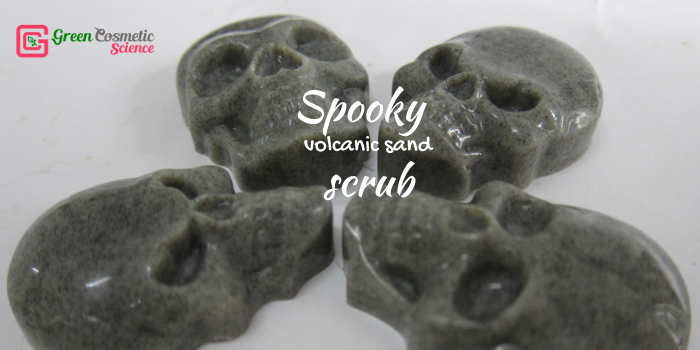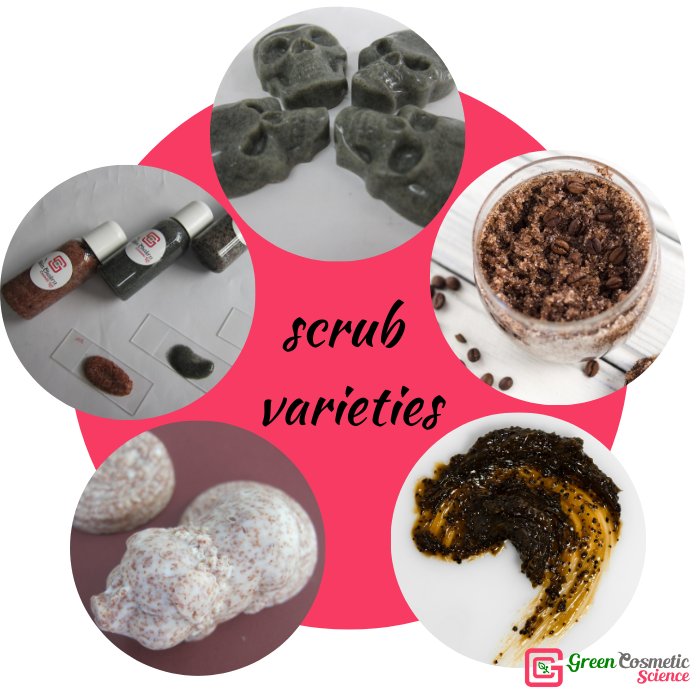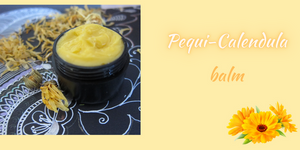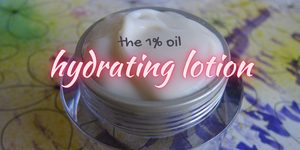
Scrubs are among the most fascination products to formulate. Physical peeling is not a modern luxury and our ancestors have used plant leaves and roots and seeds to get rid of dead skin (although they really didn't know what they are doing) and improve their complexion.
In an industrial scale, scrubs are rather a novelty and while the mainstream industry used those dreadful plastic beads that they have used in beautiful, eye catching colors (in really they were the waste of the plastic industry) the DIyers and artisanal formulators grabbed salt, sugar and coffee for this purpose. Those dreadful plastic beads are now forbidden in many parts of the world and the mainstream industry tries to reformulate their old formulations by taking the plastic beads (which were very light) with "natural" alternatives. It is always so funny when the formulators and marketing guys from the mainstream industry triy to explain you the benefits of their "sustainable and natural" alternatives for plastic beads during events and meetings.
Anyway this is another section of the industry in which the artisanal manufacturers are more progressive than the mainstream industry. There are various types of scrubs (we are still talking about physical peeling and not the chemical peeling) each one with their own advantages and limitations. Until a decade ago people (and artisanal formulators) simpley blended salt, sugar or coffee with some oil to create a crumble-like product that was rubbed over the skin and then rinsed away. Although this kind of scrub is still very popular in a DIY scale, it is loosing its popularity in a professional scale because of the risk of contamination. This kind of scrub is filled in open mouth jars and unless you create single dose packaging (which is very non-sustainable) there is no way you can guarantee that the user does not add water to the product. At the end the cosnumer ends up with a few crystals of sugar or salt in an ugly puddle whereas the rest is dissolved in the oil-water blend or, heaven forbid, there will be a contamination because the lack of an efficient preservative system.
Now we have had zillions of mails and inquiries during the last 10 years from novice formulators that intend to add a preservative to their oily scrub, just in case, the consumer adds some water to the product. We have never promoted this idea and do not give any recommendations for such inquiries. There is no way you can efficiently preserve a product that is changing as it is used up. Either to overpreserve the product from the beginning (over preserving is as bad as under preserving) or you do not preserve sufficiently.
This kind of scrub is still very pretty and sexy in the jars and is optically very appealing and you have all the freedom in the world to still make and sell them but there are other, more practical and safer ways to make and sell a scrub.

The world of scrubs has been revolutionized during teh past decade with the availability of sterilized upcycled exfoliants, mostly stone fruit powder. Today the sky is the limit and you can have everything at hand from apricot stone powder to volcanic sand to apply in your scrubs.
There are water based scrubs (hydrogels or cleansing gel scrubs) which are extremely practical to use. Here obviously you can not use sugar, salt or coffee. You need something like the stone powders.
Then there is the simple oil exfoliant (not depicted in the picture). I am not sure if they are still available commercially. They are a bottle of oil with a kind of exfoliant sitting at the bottom of the oil bottle. The consumer needs to shake the bottle before application. This is again very unpractical compared to more easily applicable scrubs but are very easy to make. You need a bottle with a nozzle stopper and you need to match the size of the nozzle to the size of the exfoliant.
Another version is a balm-exfoliant. These are extremely non-practical because they need to be filled in wide mouth jars (like the crumble version). They are pretty to look at but really not easy to use and specifically challenging for preserving.
Then there are scrub bars. These are available both as oil-based formulations (the easier version and what we are sharing today) or in a shower bar version which is slightly more difficult to make and needs some practice in making shower bars and a basic knowledge of pH measurement and adjustment.
Perhaps the most fun and modern version is the oleogel exfoliant. It combines the ease of oil exfoliant (no water, no preservation, no pH adjustment) with the ease of application of a gel.
No matter which of these types you decide to make there are a few things that you need to consider in advance.

Density
This is important for the optical appearance of the exfoliant. As I mentioned before there is no shame in making a simple oil exfoliant with the exfoliant particles sitting at the bottom of the bottle so that the consumer has to shake the bottle before use. If this is the case, make sure you communicate this with the consumer. In a hydrogel however, it will not be so appealing and practical if your exfoliant sits at the bottom of the bottle or floats on top of the liquid. What you need to do is to adjust the yield stress and viscosity and density of the product so that the exfoliant remains suspended through the whole shelf-life.
Compatibility with the carrier
As mentioned before you can not use sugar and salt in a water based formulation or herbs in an oily scrub (they become soft and mushy). Either you have a certain product type in mind and go search a suitable exfoliant for that or you have a sexy exfoliant at hand and create a product based on that certain exfoliant.
Particle size and hardness
These days scrubs are used literally from head to toe. There are scalp scrubs, lip scrubs, facial scrubs or scrubs for hands, feet and body. Obviously you need softer and smaller exfoliants for scalp and face where as feet, hand and body can tolerate harder and bigger particle.
The particle size is important for the optical appearance of the product as well as for the choose of the container in case of liquid and gel scrubs.
Preservation
Keep in mind that over preserving is as bad as under preserving. We don't add a preservative to a self-preserving system just in case....
The quality of the exfoliant plays a major role in the efficacy of the preservation when it is necessary. You can simply grind some fruit stones and herbs and flowers at home (bless your grinder in that case) but you need to efficiently decontaminate them. Commercial exfoliants are either sterilized thermally or by radiation. This means you can add them in a self-presreving system (such as an oil, balm or a bar) without the risk of moldering as long as no water enters the system.
Packaging
Makes all the difference in the success of the product and if the consumer rebuys the product. Nothing is more annoying than purchasing a product that you can not use because the packaging does not match the product concept. If your exfoliant is much bigger than the stopper nozzle, it will simply clog the nozzle or the dispensing pump and it will be a huge waste to have the bottle just sit down as a decoration in the bathroom.
Now having said that all let's jump to the formulation of this week.
Since we are in October we decided to make some spooky scrub bars. You can make these bars all year around, just use another mold for the pieces.
We are using our volcanic sand exfoliator for this purpose but you can use coffee, even salt or sugar or any fruit seed powder. The volcanic sand sounds very harsh but its hardness and particle size are so that you can even use it for facial scrub. One of our customers even uses it in a scalp scrub (don't use over 5% though for that purpose).
We are using our PG-4 oleate emulsifier to help rinsing of the scrub. This leaves the skin with a silky (and nongreasy) after rinse skin feel.
The rest is really straightforward. You need to keep a certain time window for pouring the melt in the mold cavities. If you do it very early the sand will sediment in the cavities and will not be uniformly distributed. If you pour too late the melt will start becoming solid and the pieces will not be nice and smooth.

Procedure:
1- Melt phase A in a water bath between 60-70 C
2- When it is all melted stop heating. Add phase B and start cooling down while stirring
3- When the temperature reaches <40C add the essential oils. Continue cooling down while stirring
4- At a medium trace add the volcanic sand and continue stirring to a heavy yet pourable consistency.
5- Fill the mold cavities and put the molds in the fridge for 3 hours to overnight.
One more thing about these scrub bars
You can prepare them as small or as big as you want. Making them in small peices (single dose or max. double dose size) will make it easier and more hygienic to use.
Now go and create some amazing scrub bars for Halloween or just for the sake of fun.


